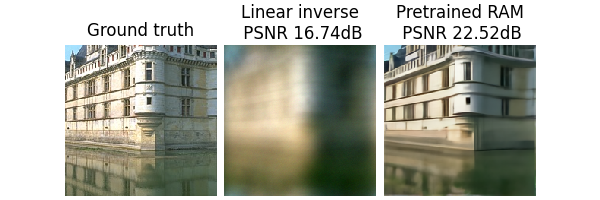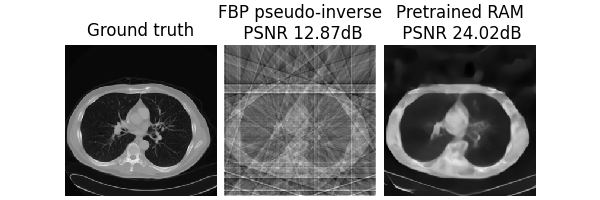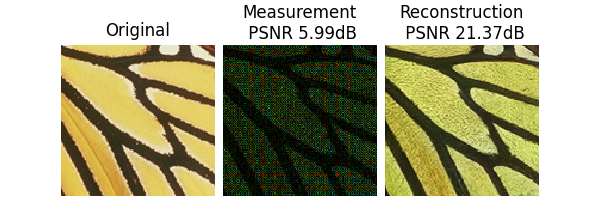Note
New to DeepInverse? Get started with the basics with the 5 minute quickstart tutorial..
Inference and fine-tune a foundation model#
This example shows how to perform inference on and fine-tune the Reconstruct Anything Model (RAM) foundation model [1] to solve inverse problems.
The Reconstruct Anything Model is a model that has been trained to work on a large
variety of linear image reconstruction tasks and datasets (deblurring, inpainting, denoising, tomography, MRI, etc.)
and is robust to a wide variety of imaging domains.
Tip
Want to use your own dataset? See Bring your own dataset
Want to use your own physics? See Bring your own physics
import deepinv as dinv
import torch
device = dinv.utils.get_freer_gpu() if torch.cuda.is_available() else "cpu"
model = dinv.models.RAM(device=device, pretrained=True)
Selected GPU 0 with 8217.25 MiB free memory
1. Zero-shot inference#
First, let’s evaluate the zero-shot inference performance of the foundation model.
Accelerated medical imaging#
Here, we demonstrated reconstructing brain MRI from an accelerated noisy MRI scan from FastMRI:
x = dinv.utils.load_example("demo_mini_subset_fastmri_brain_0.pt", device=device)
# Define physics
physics = dinv.physics.MRI(noise_model=dinv.physics.GaussianNoise(0.05), device=device)
physics_generator = dinv.physics.generator.GaussianMaskGenerator(
(320, 320), device=device
)
# Generate measurement
y = physics(x, **physics_generator.step())
# Perform inference
with torch.no_grad():
x_hat = model(y, physics)
x_lin = physics.A_adjoint(y)
psnr = dinv.metric.PSNR()
dinv.utils.plot(
{
"Ground truth": x,
f"Linear inverse": x_lin,
f"Pretrained RAM": x_hat,
},
subtitles=[
"PSNR:",
f"{psnr(x, x_lin).item():.2f} dB",
f"{psnr(x, x_hat).item():.2f} dB",
],
figsize=(6, 4),
)

Computational photography#
Joint random motion deblurring and denoising, using a cropped image from color BSD:
x = dinv.utils.load_example("CBSD_0010.png", img_size=(200, 200), device=device)
physics = dinv.physics.BlurFFT(
img_size=x.shape[1:],
noise_model=dinv.physics.GaussianNoise(sigma=0.05),
device=device,
)
# fmt: off
physics_generator = (
dinv.physics.generator.MotionBlurGenerator((31, 31), l=2.0, sigma=2.4, device=device) +
dinv.physics.generator.SigmaGenerator(sigma_min=0.001, sigma_max=0.2, device=device)
)
# fmt: on
y = physics(x, **physics_generator.step())
with torch.no_grad():
x_hat = model(y, physics)
x_lin = physics.A_adjoint(y)
dinv.utils.plot(
{
"Ground truth": x,
f"Linear inverse": x_lin,
f"Pretrained RAM": x_hat,
},
subtitles=[
"PSNR:",
f"{psnr(x, x_lin).item():.2f} dB",
f"{psnr(x, x_hat).item():.2f} dB",
],
figsize=(6, 4),
)

Tomography#
Computed Tomography with limited angles using data from the The Cancer Imaging Archive of lungs:
x = dinv.utils.load_example("CT100_256x256_0.pt", device=device)
physics = dinv.physics.Tomography(
img_width=256,
angles=10,
normalize=True,
device=device,
)
y = physics(x)
with torch.no_grad():
x_hat = model(y, physics)
x_lin = physics.A_dagger(y)
dinv.utils.plot(
{
"Ground truth": x,
f"FBP pseudo-inverse": x_lin,
f"Pretrained RAM": x_hat,
},
subtitles=[
"PSNR:",
f"{psnr(x, x_lin).item():.2f} dB",
f"{psnr(x, x_hat).item():.2f} dB",
],
figsize=(6, 4),
)

Power iteration converged at iteration 10, ||A^T A||_2=2477.74
Remote sensing#
Satellite denoising with Poisson-Gaussian noise using urban data from the WorldView-3 satellite over Jacksonville:
x = dinv.utils.load_example("JAX_018_011_RGB.tif", device=device)[..., :300, :300]
physics = dinv.physics.Denoising(
noise_model=dinv.physics.PoissonGaussianNoise(sigma=0.1, gain=0.1)
)
y = physics(x)
with torch.no_grad():
x_hat = model(y, physics)
# Alternatively, use the model without physics:
# x_hat = model(y, sigma=0.1, gain=0.1)
x_lin = physics.A_adjoint(y)
dinv.utils.plot(
{
"Ground truth": x,
f"Linear inverse": x_lin,
f"Pretrained RAM": x_hat,
},
subtitles=[
"PSNR:",
f"{psnr(x, x_lin).item():.2f} dB",
f"{psnr(x, x_hat).item():.2f} dB",
],
figsize=(6, 4),
)

2. Fine-tuning#
As with all models, there may be a drop in performance when used zero-shot on problems or data outside those seen during training.
For instance, RAM is not trained on image demosaicing:
x = dinv.utils.load_example("butterfly.png", img_size=(127, 129), device=device)
physics = dinv.physics.Demosaicing(
img_size=x.shape[1:], noise_model=dinv.physics.PoissonNoise(0.1), device=device
)
# Generate measurement
y = physics(x)
# Run inference
with torch.no_grad():
x_hat = model(y, physics)
# Show results
dinv.utils.plot(
{
"Original": x,
f"Measurement": y,
f"Reconstruction": x_hat,
},
subtitles=[
"PSNR:",
f"{psnr(x, y).item():.2f} dB",
f"{psnr(x, x_hat).item():.2f} dB",
],
figsize=(6, 4),
)

To improve results, we can fine-tune the model on our problem and data, even in the absence of ground truth data, using a self-supervised loss, and even on a single image only.
Here, since this example is run in a no-GPU environment, we will use a small patch of the image to speed up training, but in practice, we can use the full image.
Note
You can also fine-tune on larger datasets if you want, by replacing the dataset.
# Take small patch
x_train = x[..., :64, :64]
physics_train = dinv.physics.Demosaicing(
img_size=x_train.shape[1:],
noise_model=dinv.physics.PoissonNoise(0.1, clip_positive=True),
device=device,
)
y_train = physics_train(x_train)
# Define training loss
losses = [
dinv.loss.R2RLoss(),
dinv.loss.EILoss(dinv.transform.Shift(shift_max=0.4), weight=0.1),
]
dataset = dinv.datasets.TensorDataset(y=y_train)
train_dataloader = torch.utils.data.DataLoader(dataset)
We fine-tune using early stopping on a validation set, again without ground truth. We use a small patch of another set of measurements as validation.
eval_dataloader = torch.utils.data.DataLoader(
dinv.datasets.TensorDataset(
y=physics_train(
dinv.utils.load_example("leaves.png", device=device)[..., :64, :64]
)
)
)
max_epochs = 20
trainer = dinv.Trainer(
model=model,
physics=physics_train,
eval_interval=5,
ckp_interval=max_epochs - 1,
metrics=None,
compute_eval_losses=True, # use self-supervised loss for evaluation
early_stop_on_losses=True, # stop using self-supervised eval loss
early_stop=2, # early stop after 2 evals without improvement
device=device,
losses=losses,
epochs=max_epochs,
optimizer=torch.optim.Adam(model.parameters(), lr=5e-5),
train_dataloader=train_dataloader,
eval_dataloader=eval_dataloader,
show_progress_bar=False, # disable progress bar for better vis in sphinx gallery.
)
finetuned_model = trainer.train()
finetuned_model = trainer.load_best_model()
/local/jtachell/deepinv/deepinv/deepinv/training/trainer.py:1352: UserWarning: non_blocking_transfers=True but DataLoader.pin_memory=False; set pin_memory=True to overlap host-device copies with compute.
self.setup_train()
The model has 35618813 trainable parameters
Train epoch 0: R2RLoss=0.133, EILoss=0.001, TotalLoss=0.134
Eval epoch 0: R2RLoss=0.154, EILoss=0.001, TotalLoss=0.154
Best model saved at epoch 1
Train epoch 1: R2RLoss=0.129, EILoss=0.0, TotalLoss=0.129
Train epoch 2: R2RLoss=0.124, EILoss=0.0, TotalLoss=0.125
Train epoch 3: R2RLoss=0.124, EILoss=0.0, TotalLoss=0.124
Train epoch 4: R2RLoss=0.132, EILoss=0.0, TotalLoss=0.132
Train epoch 5: R2RLoss=0.122, EILoss=0.0, TotalLoss=0.122
Eval epoch 5: R2RLoss=0.15, EILoss=0.001, TotalLoss=0.151
Best model saved at epoch 6
Train epoch 6: R2RLoss=0.124, EILoss=0.0, TotalLoss=0.124
Train epoch 7: R2RLoss=0.127, EILoss=0.0, TotalLoss=0.127
Train epoch 8: R2RLoss=0.13, EILoss=0.0, TotalLoss=0.13
Train epoch 9: R2RLoss=0.127, EILoss=0.0, TotalLoss=0.127
Train epoch 10: R2RLoss=0.133, EILoss=0.0, TotalLoss=0.133
Eval epoch 10: R2RLoss=0.151, EILoss=0.001, TotalLoss=0.151
Train epoch 11: R2RLoss=0.123, EILoss=0.0, TotalLoss=0.123
Train epoch 12: R2RLoss=0.133, EILoss=0.0, TotalLoss=0.134
Train epoch 13: R2RLoss=0.131, EILoss=0.0, TotalLoss=0.131
Train epoch 14: R2RLoss=0.122, EILoss=0.0, TotalLoss=0.122
Train epoch 15: R2RLoss=0.124, EILoss=0.0, TotalLoss=0.125
Eval epoch 15: R2RLoss=0.154, EILoss=0.001, TotalLoss=0.154
Train epoch 16: R2RLoss=0.126, EILoss=0.0, TotalLoss=0.126
Train epoch 17: R2RLoss=0.126, EILoss=0.0, TotalLoss=0.126
Train epoch 18: R2RLoss=0.121, EILoss=0.0, TotalLoss=0.121
Train epoch 19: R2RLoss=0.129, EILoss=0.0, TotalLoss=0.129
Eval epoch 19: R2RLoss=0.16, EILoss=0.001, TotalLoss=0.161
Early stopping triggered at epoch 19 as validation metrics have not improved in the last 2 validation steps. Disable it with early_stop=None, or modify early_stop>0 to wait for more validation steps.
Model, optimizer, epoch_start successfully loaded from checkpoint: 25-12-17-16:16:36/ckp_best.pth.tar
We can now use the fine-tuned model to reconstruct the image from the measurement y.
with torch.no_grad():
x_hat_ft = finetuned_model(y, physics)
# Show results
dinv.utils.plot(
{
"Original": x,
f"Measurement": y,
f"Zero-shot \nReconstruction": x_hat,
f"Fine-tuned \nReconstruction": x_hat_ft,
},
subtitles=[
"PSNR:",
f"{psnr(y, x).item():.2f} dB",
f"{psnr(x, x_hat).item():.2f} dB",
f"{psnr(x, x_hat_ft).item():.2f} dB",
],
figsize=(6, 4),
)

- References:
Total running time of the script: (0 minutes 16.917 seconds)

